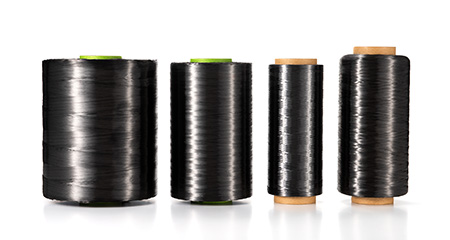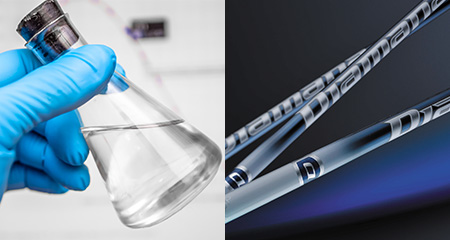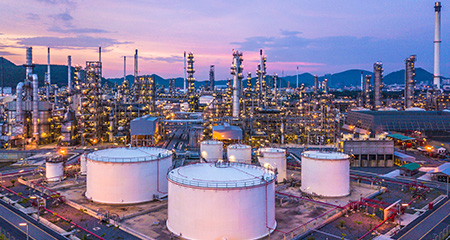What Are Carbon Fiber & Carbon Fiber Reinforced Plastics?
Mitsubishi Chemical's Carbon Fiber Business
Mitsubishi Chemical's carbon fiber reinforced plastics business was started by integrating two business arms; that of PAN-based (petroleum-derived) carbon fiber, which was a product of Mitsubishi Rayon; and that of pitch-based (coal-derived) carbon fiber, which was a product of Mitsubishi Plastics. The following is an introduction to the features of Mitsubishi's carbon fiber products, which have become even more attractive due to the synergistic effects of the business integration.
Three Major Features:
Feature 1
Manufacturer of both PAN- and pitch-based carbon fibers
PAN is an abbreviation for "polyacrylonitrile," a polymer used to make acrylic fiber. PAN-based carbon fiber obtained from acrylic fiber is excellent for achieving strength, and has favorable handling properties.
Pitch is a sticky material that is produced during coal and oil refining. Mitsubishi Chemical manufactures carbon fiber from anisotropic pitch, which is prepared from coal. Pitch-based carbon fiber prepared from anisotropic pitch is particularly good in terms of its elastic modulus.
On the basis of a wide variety of carbon fibers prepared from two types of raw material, we can not only provide carbon fibers that meet customers' requirements, but also freely design intermediate materials and molded products.

Feature 2
In-house manufacturing from raw materials to processed products: Vertical integration
We perform in-house manufacturing and marketing of acrylonitrile (the raw material for PAN-based carbon fiber), coal pitch (the raw material for pitch-based carbon fiber), carbon fiber, various intermediate materials such as prepreg and SMC, and molded products such as golf shafts and rolls.
Our global supply chain of carbon fiber reinforced plastics, from upstream (raw materials) to downstream (CFRP molded products), enables us to maintain a global presence, providing optimal products to customers worldwide.

Feature 3
Proposed capabilities as an integrated chemical manufacturer
As an integrated chemical manufacturer, Mitsubishi Chemical possesses various technologies and extensive knowledge relating to carbon fiber reinforced plastics, including chemical and physical analysis technology; technologies for thermosetting/thermoplastic resins combined with carbon fiber; and performance evaluation and simulation technologies for reinforced plastics. We can provide not only products but also optimal solutions.

History
The history of carbon fiber is surprisingly long, dating back to 1848 when the British physicist Joseph Swan first used paper as a filament for an incandescent light bulb. The bamboo filament in Edison's famous invention, the light bulb, can also be said to be a type of carbon fiber.
After tungsten was adopted for light bulb filaments, carbon fiber disappeared from the stage of history, but later came back into the spotlight due to its superior performance.
Here we introduce the history of carbon fiber and Mitsubishi Chemical's development of this material.
Before the business integration, PAN-based carbon fiber was handled by Mitsubishi Rayon, and pitch-based carbon fiber was handled by Mitsubishi Chemical Industries, Mitsubishi Kasei, Mitsubishi Chemical Functional Products, and Mitsubishi Plastics.
PAN-based carbon fiber
Pitch-based carbon fiber
-
1959
Dr. Akio Shindo of the Osaka Industrial Research Institute filed a patent for a
PAN-based carbon fiber production method. -
1963
Dr. Sugio Otani of Gunma University succeeded in producing
carbon fiber from pitch. -
1967
Courtaulds PLC in the UK started mass production of
PAN-based carbon fiber. -
1969
Dr. Sugio Otani of Gunma University discovered that anisotropic pitch (mesophase pitch), prepared by heat-treating pitch, can be used as a raw material to produce carbon fiber with high-level physical properties.
-
1972
Mitsubishi Rayon started development of PAN-based carbon fiber.
-
1976
Mitsubishi Rayon started production of prepreg in Aichi.
-
1978
Mitsubishi Chemical Industries started development of pitch-based carbon fiber.
-
1983
Mitsubishi Rayon started mass production of PAN-based carbon fiber.
-
1987
Mitsubishi Chemical Industries started mass production of pitch-based carbon fiber, and Kasei Fiberlite Co. started prepreg production.
-
1990
Mitsubishi Rayon acquired US prepreg manufacturer
Newport Adhesives and Composites (now Mitsubishi Chemical
Carbon Fiber and Composites). -
Mitsubishi Kasei's C/C composites using pitch-based carbon fiber were used in the brakes for the world's most prestigious motorcycle race (MotoGP).
-
1991
Mitsubishi Rayon acquired
US carbon fiber manufacturer Grafil,
from Courtaulds in the UK (now Mitsubishi Chemical
Carbon Fiber and Composites). -
1995
MRCP (now MCCP) established.
Full-scale production of golf shafts started, as an original equipment manufacturer (OEM). -
1999
Mitsubishi Kasei's high-elasticity, pitch-based carbon fiber was used to reinforce the cast-iron structure of the world's oldest underground railway, in London.
-
2005
Mitsubishi Rayon launched its own brand, "DIAMANA,"
and made a full-scale entry into the golf club reshafting market. -
2008
Mitsubishi Plastics' high-elasticity, pitch-based carbon fiber was used for the robotic arm of the International Space Station (ISS) Experiment Module "Kibo".
-
2010
Mitsubishi Rayon and SGL jointly established
MRC-SGL Precursor Co. Ltd. (now MCC-SGL
Precursor Co. Ltd.), to supply precursors for BMW's i3/i8 electric vehicles
. -
2011
Mitsubishi Rayon started mass production of PAN-based large-tow carbon fiber
. -
Mitsubishi Plastics' pitch-based carbon fiber was adopted for the ALMA Project (an internationally collaborative project by the USA, Europe, and Japan to explore deep space by installing numerous large radio-telescopes in Chile).
-
2012
Mitsubishi Rayon acquired Challenge Co., Ltd., a pioneer in CFRP manufacturing for the racing car field
. -
2013
Mitsubishi Rayon acquired Aldila, Inc., the largest manufacturer of golf shafts in the USA.
Business integration
-
2015
Mitsubishi Rayon's PAN-based carbon fiber business and Mitsubishi Plastics' pitch-based carbon fiber business were integrated (continuing as Mitsubishi Rayon).
-
2016
With the world's first successful mass production of pitch-based carbon fiber, it was recorded in "Important Materials for the History of Science and Technology: Future Engineering Heritage".
-
2017
With the establishment of Mitsubishi Chemical, the carbon fiber business started as the new Mitsubishi Chemical.
Mitsubishi Chemical's carbon fiber SMC (FMC) was used in the back door of Toyota's Prius PHV.
Mitsubishi Chemical made a 44% investment in C.P.C. Srl, an Italian manufacturer of CFRP automotive parts. -
2018
Mitsubishi Chemical's CARBOLEADER™, a 350 x 9200 mm carbon-clad roll, was recorded in "Important Materials for the History of Science and Technology: Future Engineering Heritage".
-
2020
Mitsubishi Chemical acquired German prepreg manufacturer c-m-p GmbH.
-
CONTINUING IN THE FUTURE